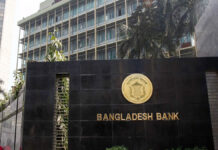Grand money laundering scheme
How BB foiled Shahidul Ahsan’s plan to buy shares of Peoples Bank with loans from First Security Islami Bank

Layering is one of the most popular methods for money launderers as it makes it harder for financial regulators and law enforcement agencies to sniff out the money trail.
The first step under the method involves introducing cash into the financial system by some means (“placement”).
The second involves carrying out complex financial transactions to camouflage the illegal source of the cash (“layering”). Lastly, the wealth generated from the transactions of the illicit funds is put back into the financial system (“integration”).
Md Shahidul Ahsan, chairman of Ahsan Group, and Abul Kashem, chairman of proposed Peoples Bank, thought they had carried out the three steps flawlessly, but they were not clean enough to get past the open-eyed Bangladesh Financial Intelligence Unit (BFIU) and the Bangladesh Bank.
THE GRAND PLAN
Ahsan’s endgame was to gain ownership of the proposed Peoples Bank. He attempted to purchase shares in the name of one of his companies: AG Green Property Development.
But, he was not willing to put in his own money for the endeavour, found the probe by the BFIU and two other inspection departments of the central bank, which spent the first half of last year to unearth the sensational laundering case.
The Daily Star obtained copies of the probe reports.
Instead, he took out a loan of Tk 75 crore from the Banani branch of First Security Islami Bank’s (FSIBL), saying he would be purchasing construction equipment with the sum.
As per banking rules, a person has to spend his/her own net worth to purchase more than 5 percent shares of a bank.
Ahsan, who was then a director of Mercantile Bank, was well aware of this, which is why he sent the funds through five banks to bury their source.
A portion of the fund was deposited at Mercantile Bank’s Mohakhali branch, of which Tk 10 crore was withdrawn and paid to Kashem by issuing two pay orders.
Kashem opened accounts with five banks in a week in January 2018, where he deposited the amount. In so doing, he thought he had concealed the fact that Ahsan was the actual source of the funds, said the BB reports.
The names of the five banks are being withheld as they could not be reached for comments.
UNDOING OF PLAN
The central bank got wind of the scheme when Abul Kashem was proposed as the chairman for Peoples Bank, which has been trying to get a licence since 2017.
Kashem was asked to submit documents of his net assets as part of the process of getting licence for the new bank — a move that unravelled both Ahsan and Kashem’s plan.
He has net assets worth Tk 43.94 crore in the US, where he resides, and Tk 56.92 lakh in Bangladesh, according to the documents provided by him to the central bank.
This means, he would have to sell off about 90 percent of his assets to purchase shares in Peoples Bank — a move that many would consider to be baffling.
Other than this oddity, the central bank found discrepancy in his net asset certificate by a New York-based accountancy firm by the name of Rafiq & Associates, CPA, LLC.
In the hard copy furnished to the BB by Kashem in February last year the firm’s name differed in the letterhead and the stamp.
Subsequently, the central bank stalled the process of giving licence to Peoples Bank in February last year and started an investigation against Kashem.
It was during this investigation that Ahsan came under the scanner of BFIU and the BB.
STEPS AGAINST AHSAN
The probe found that Ahsan’s actions went against the interest of both Mercantile Bank and depositors.
In September last year the central bank was compelled to initiate the process of removing Ahsan from the Mercantile Bank board, the BB report said.
Ahsan was asked on September 8 last year to explain the money laundering trail that the BFIU had discovered.
But his explanation did not pass muster and the central bank asked him to take part in a personal hearing before the BB’s standing committee on December 12 last year.
After completion of the hearing, the standing committee recommended the central bank’s higher ups that Ahsan had lost his moral ground to continue as the director of Mercantile Bank.
Ahsan also served as the chairman of the executive committee of Mercantile Bank.
As part of the central bank move against Ahsan, Mercantile was finally asked on January 2 to remove Ahsan from its board of directors.
“Ahsan did not use the loans taken from FSIBL in the sectors mentioned in his credit proposal. Rather, he layered the money in order to perpetrate money laundering,” said Md Serajul Islam, spokesperson and an executive director of the BB.
The lender had complied with the instruction on Sunday by removing Ahsan from the board, said Mati Ul Hasan, spokesperson and additional managing director of Mercantile Bank.
His replacement in the Mercantile board was elected on the same day.
He will not be allowed to participate in the management of any bank over the next three years, according to the central bank decision.
The Daily Star could not reach Kashem, whose mobile phone was switched off. Ahsan did not answer his phone calls and reply to text message requests for comment. FSIBL was not available for comment.









